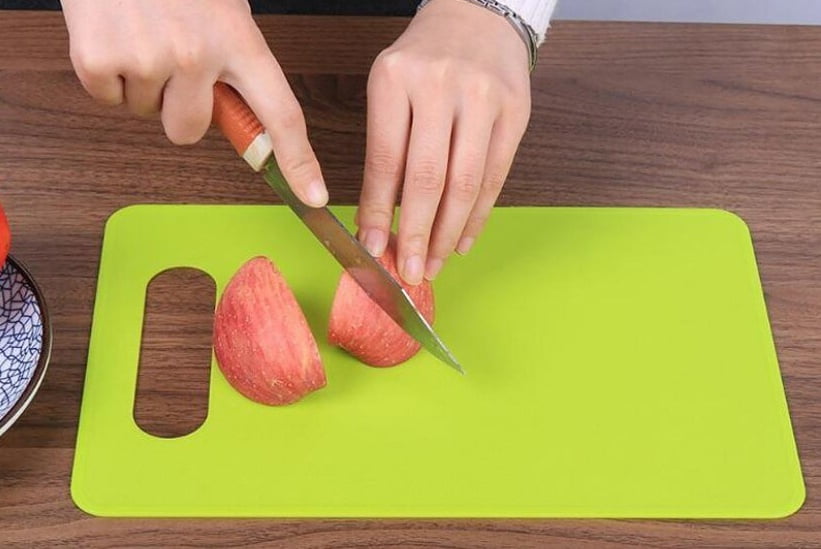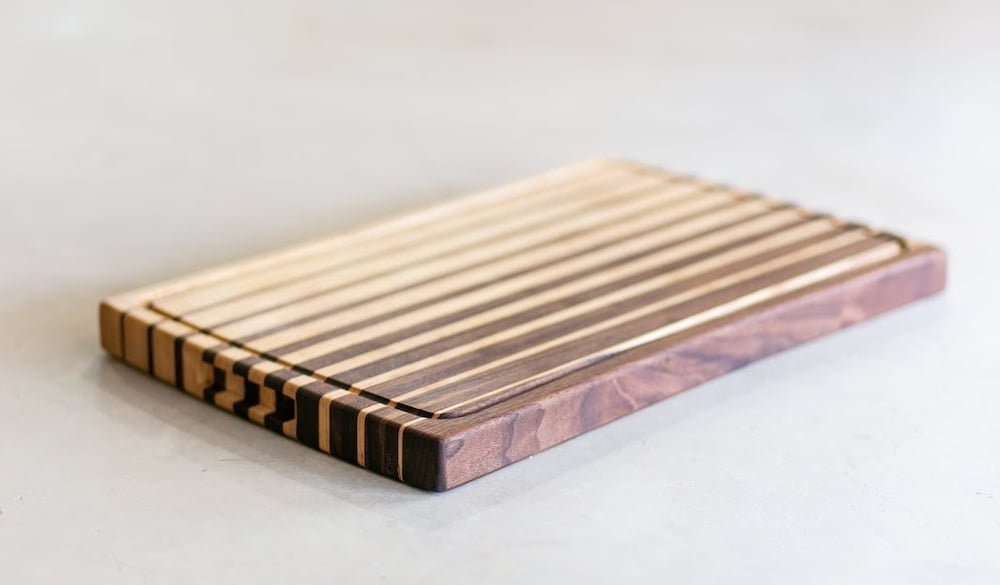A cutting board is one of the “essentials” when it comes to kitchen tools. Most likely you are using one every day or almost every day at home. There are also heavy-duty tasks that need to be done several times a day in a professional kitchen. But not every cutting board is strong enough to handle the heavy use. It is said that a good cutting board will bring peace to the kitchen because it keeps things clean and in order, protects your hands and fingers, makes cooking easier, and looks nice on your table. It will also protect the cutting edge of your knives, making them last longer. In this post we will list best wood for cutting board.
Professional cooks know that the best cutting board is one made of wood. This works in small kitchens and homes as well. In this post, we will see what is the best wood for chopping boards.
Table of Contents
1. Why is wood better than other materials?
Most people in professional kitchens agree that wood cutting boards are better than bamboo, plastic, and other materials when it comes to a cutting surface. Below are the reasons why wooden boards make them better than other materials.
- Wooden cutting boards are clean and kill germs, so they keep food safe. Because the cellulose that is naturally found in wood kills germs on the surface and in the fibres.
- They’re great for bread, meat, and all kinds of other things.
- If you take good care of it, a wooden cutting board is very sturdy and can last almost forever.
- Wood can stand up to heavy use every day, even in the busy kitchen.
- This material won’t damage your tools’ edges as much as others.
- Wooden cutting boards can handle heat, so you can put pots and pans on them.
- Having a wood cutting board is a beautiful thing that will always look classy.
- They come in a range of styles, prices, and woods, such as maple, beech, birch, teak, walnut, and pine.
Cutting boards made of Wood vs Plastic

The thing about plastic cutting boards is that they can’t promise the right amount of food safety like wood can. When cutting, it’s easy to scratch the surface of plastic boards, and germs are likely to grow in the resulting holes.
Also, plastic boards don’t last as long and quickly lose their appeal and quality. It’s not fun to buy plastic boards over and over again all year.
Wood is also stronger than plastic, which is something else that plastic can’t do. After all, you’ll be using a sharp knife close to your fingers, and if you move, the chopping board could move quickly and hurt you (too dramatic?). It’s possible, but not likely.
Stone vs. Wood
An honest answer is that a wood cutting board is a good choice. They are good for the earth, and a good bamboo board can also keep food safe and clean. The bad news is that bamboo is harder than wood and makes knife blades dull. This is also true for cutting boards made of other materials, like pottery and glass. So, wood is still the best choice, even if it’s just for you.
2. Edge Grain vs. End Grain

It’s important to note that there are two main types of wood grain in chopping boards: end grain and edge grain.
Edge Grain cutting boards have been around for a long time. To get this kind of wood grain, you arrange and glue the edges of several strips of wood together. Edge grain boards are generally made from hardwoods like maple or cherry, so the designs on the surface are usually very pretty.
If wooden boards are the best, then End Grain cutting boards are the best of the best. They are made by putting together the ends of several small pieces of wood vertically. End grain boards have a grid pattern on their surface because of this. Sometimes you can even see the tree’s growth rings on them.
The “self-healing” power of end grain cutting boards is great. This means that the wood fibres will return to their original shape after being cut. Also, they are gentler on the edge of your knife and keep it sharp longer.

3. Wooden vs. softwood
There are different hardness levels for the same type of wood, which will affect how well it works for cutting boards and other uses. Hickory, cedar, pine, and oak are all softwoods. Teak, cherry, maple, walnut, and bamboo are all hardwoods.
The Janka hardness scale was created by the Austrian dendrologist Gabriel Janka in 1906 and is used to measure how hard wood is. In this case, “lbf” stands for pounds of force. Each number represents a different hardness level for each wood. For example, balsa wood has a hardness level of 22 and buloka wood has a hardness level of +5000.
Too hard of a wood will make your knife dull, but too soft of a wood will make it easy to damage and scratch. The Janka hardness scale says that the best woods for cutting boards are those that are between 900 and 1500.
4. Best Wood for Cutting Board Material
Teak

Because it has a closed grain, teak is very resistant to germs, water, and dirt. This is why it has been used for boats and furniture for a long time. The material is very strong and looks great as a cutting board.
Also, teak keeps its natural oils better and longer than maple or walnut, so cutting boards made of teak don’t need to be oiled or conditioned as often as those made of maple or walnut.
The silica in teak makes it hard enough to be strong and durable (about 1000 lbf on the Janka hardness test), but not so hard that it will dull your knife.
Malaysians grow teak, a brown or orange wood that is used to make cutting boards.
Maple
This is likely the most popular type of wood used to make cutting boards. A wood cutting board, which got a score of 1,450 lbf on the Janka test, is the best kind of hard for your cooking knives. Maple also doesn’t let bacteria grow on its skin because it has small holes.
Also, they are lighter than other woods, which makes spots stand out more… Besides that, they’re simple to keep clean and in good shape.
Beech tree
Beech is another common choice for cutting boards. It is safe for food, hard (1300 lbf), and fairly resistant to contact. It also doesn’t scratch, stain, or get wet.
Beech isn’t too expensive, but it will need more care and work from you. Because it shrinks quickly, you’ll have to condition it every month, and since it’s lighter, you’ll have to be extra careful with food stains.

Cherry Walnut
Because it is only 1,010 lbf hard, walnut is the softest of the trees used for cutting boards. The cutting edge of your knife is safe on a walnut cutting board, but the board is more likely to dent, bend, or scratch.
Walnut can still be eaten, and it won’t need as much treatment as the other nuts on this list.
The darker colours of walnut might be its best feature, which is great for kitchens that get a lot of use.
5. Woods to Avoid for Cutting Boards
When looking for wood for your cutting board, you should stay away from three traits: wood that is too soft, too porous, or too poisonous.
Softwoods will get cut marks all over the surface very fast. Also stains. This is not only unpleasant to look at, but it also makes the food and the kitchen less clean. Balsa, cedar, juniper pine, redwood, and spruce are all softwoods that you should stay away from.
Porous woods are also not a good idea. Because it has a lot of holes, your cutting board will get smelly, stained, mouldy, and full of bugs over time. Mahogany, butternut, oak, and ash are all porous woods.
Poisonous woods are bad for your health. There are types of wood that are very poisonous and shouldn’t be used for cooking tools or in touch with food. Some woods are poisonous, like pine, birch, and mahogany. You should be safe as long as you only use wood from trees that have fruits that you can eat.
6. How to Clean Wooden Chopping Board
No matter what kind of material they are made of, all cutting boards need to be constantly watched to make sure they are clean and safe. These are some important points:
Cross-contamination: Some foods, like raw meat, contain bacteria that are meant to be killed when the food is cooked. These bacteria could spread to other foods, like bread or fresh fruits and veggies. It is best to use separate cutting boards for each to avoid this. Wooden cutting boards are better for cutting raw meat, chicken, and fish because they don’t have pores.
Every time you use a cutting board, wash it with warm or hot soapy water. Food juices and other liquids should not stay on the wooden surface for too long. This is especially true for raw meat juices.
Cleaning solution: You can clean your boards with a special solution every once in a while to keep them even cleaner. For cutting boards made of wood, you can use an ammonia cleaner, which is better for natural materials.
Dry: Your cutting boards need to dry fully after washing them because bacteria like it when things are wet. Let it dry in the air or use a paper towel (not a tea towel).
Change it. We suggest that you look over your cutting board every once in a while. If you can see deep cuts in your cutting board, it’s time to get a new one. This can happen with any kind of cutting board, but if you get a good wooden one, it won’t happen as often as it might with, say, a plastic one.

